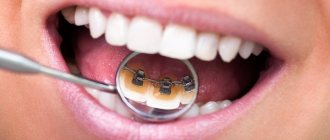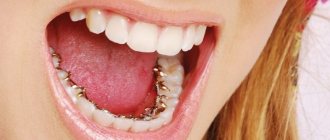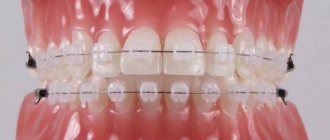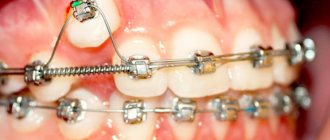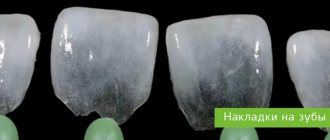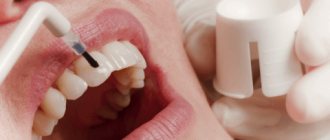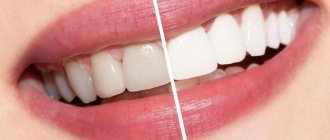Lingual braces are special brace systems that are fixed on the inner (lingual) side of the tooth. The structures have a great advantage - they are completely invisible to others. They are located behind the teeth, so only the patient and his doctor know about the treatment. Like any other orthodontic appliance, lingual braces have pros and cons. The disadvantages include impaired diction, a longer period of adaptation, and difficult hygienic care. Modern manufacturers are constantly improving braces to make them as effective and comfortable as possible.
Types of lingual braces
Experts distinguish two main types of lingual braces depending on the manufacturer: Incognito and WIN. These are individual designs that are made for each specific case and take into account all the characteristics of the patient’s oral cavity. Therefore, they are comfortable, contribute to quick adaptation and high-quality treatment.
WIN bracket systems are made of cobalt-chrome alloy. Several types of clasps are available, and the base for them is made individually, taking into account the relief of the tooth surface. The designs feature a flat design that adapts to the teeth. The arches to the systems are bent to the shape of the dentition using a special robot.
The Incognito system is distinguished by its construction made of gold alloy. The advantages include hypoallergenicity, lack of oxidation and formation of an oxide film. The bracket system is manufactured using advanced technologies, takes into account all the features of the dentition, and is therefore comfortable to use. The production process is carried out in the TOP Service laboratory in Germany. The system has proven itself well all over the world and has proven its effectiveness.
Main characteristics of lingual braces
The lingual brace system has a number of features:
- Consists of clasps, a special base for them, and an orthodontic arch;
- The arch is fixed in braces thanks to a special mechanism; rubber bands are used extremely rarely;
- Thanks to the special base, which is made individually for each patient, the design is comfortable;
- Braces are small in size;
- The structures are completely hidden from others;
- The treatment process is faster;
- Diction problems may occur during the first stages of treatment;
- Longer period of habituation and adaptation.
Cost of installing braces
| ORD-01 | Course of treatment using a brace system (for the upper and lower dentition): | |
| ORD-1.01 | Treatment with a metal brace system. I degree of severity | 113,000.00 ₽ |
| ORD-1.02 | Treatment with a metal brace system. II degree of severity | 158,200.00 ₽ |
| ORD-1.03 | Treatment with a metal brace system. III degree of severity | 158,200.00 ₽ |
| ORD-1.04 | Aesthetic bracket system: I degree of severity | 70,000.00 ₽ |
| ORD-1.05 | Aesthetic bracket system: II degree of severity | 80,000.00 ₽ |
| ORD-1.06 | Aesthetic bracket system: III degree of severity | 90,000.00 ₽ |
| ORD-1.07 | Self-ligating metal bracket system: I degree of severity | 70,000.00 ₽ |
| ORD-1.08 | Self-ligating metal bracket system: II degree of severity | 80,000.00 ₽ |
| ORD-1.09 | Self-ligating metal bracket system: III degree of severity | 90,000.00 ₽ |
| ORD-1.10 | Self-ligating aesthetic bracket system: I degree of severity | 80,000.00 ₽ |
| ORD-1.11 | Self-ligating aesthetic bracket system: II degree of severity | 90,000.00 ₽ |
| ORD-1.12 | Self-ligating aesthetic bracket system: III degree of severity | 100,000.00 ₽ |
| ORD-1.13 | Lingual braces: Children and teenagers | 90,000.00 ₽ |
| ORD-1.14 | Lingual braces: Adults | 110,000.00 ₽ |
| ORD-1.15 | Technique 2*41 dentition | 33,900.00 ₽ |
| ORD-1.16 | Preparation before orthopedics 1st quadrant | 22,600 ₽ |
| ORD-1.17 | Treatment with a ceramic bracket system. 1st degree of severity | 124,300 ₽ |
| ORD-1.18 | Treatment with a ceramic brace system. 2nd degree of severity | 146,900.00 ₽ |
| ORD-1.19 | Treatment with a ceramic brace system. 3rd degree of severity | 169,500.00 ₽ |
| ORD-1.20 | Treatment with a lingual brace system. 1st degree of severity | 135,600.00 ₽ |
| ORD-1.21 | Treatment with a lingual brace system. 2nd degree of severity. | 158,200.00 ₽ |
| ORD-1.22 | Treatment with a lingual brace system. 3rd degree of severity | 180,800.00 ₽ |
| ORD-1.23 | Observation, activation of the orthodontic apparatus | 1,000.00 ₽ |
| ORD-1.24 | Observation, activation of the orthodontic apparatus | 5,500.00 ₽ |
| ORD-1.25 | Fixation of the braces system on 1 row of teeth. | 15,000.00 ₽ |
| ORD-1.26 | Fixation of 1 metal bracket | 2,260.00 ₽ |
| ORD-1.27 | Fixation of 1 ceramic bracket | 2,830.00 ₽ |
| ORD-1.28 | Fixation of 1 lingual bracket | 3,390.00 ₽ |
| ORD-1.29 | Fixation of the buccal tube | 2,830 ₽ |
| ORD-1.30 | Bracket re-attachment/reposition | 900.00 ₽ |
| ORD-1.31 | Fixation of the orthodontic ring | 2,260.00 ₽ |
| ORD-1.32 | Re-fixation of the orthodontic ring | 570.00 ₽ |
| ORD-1.33 | Fixing the orthodontic button | 1,130.00 ₽ |
| ORD-1.34 | Fitting and applying a metal arc. | 2,260.00 ₽ |
| ORD-1.35 | Fitting and applying an aesthetic arch. | 3,390.00 ₽ |
| ORD-1.36 | Fitting and applying the reversal arc. | 2,830.00 ₽ |
| ORD-1.37 | Making and fixing a palatal clasp. | 5,650.00 ₽ |
| ORD-1.38 | Changing ligatures on 1 row of teeth. | 1,130.00 ₽ |
| ORD-1.39 | Fixation of 1 link of the elastic chain (chain) | 110.00 ₽ |
| ORD-1.40 | Fixation of open/closed spring. | 570.00 ₽ |
| ORD-1.41 | Spring activation. | 230.00 ₽ |
| ORD-1.42 | Fixing the stopper/hook on the arch | 450.00 ₽ |
| ORD-1.43 | Fixation of Kobayashi's ligature/hook | 340.00 ₽ |
| ORD-1.44 | Application of elastic intermaxillary traction. | 570.00 ₽ |
| ORD-1.45 | Occlusal pad | 900.00 ₽ |
| ORD-1.46 | Approximal reduction of enamel in the area of 1 tooth. | 170.00 ₽ |
| ORD-1.47 | Removal of 1 unit of orthodontic appliance, tooth treatment | 570.00 ₽ |
| ORD-1.48 | Selective grinding of 1 tooth | 340.00 ₽ |
| ORD-02 | Course of treatment using a braces system (for one row of teeth): | |
| ORD-2.01 | Metal braces system 1 row of teeth | 25,990.00 ₽ |
| ORD-2.02 | Metal braces system for 2 rows of teeth | 45,200.00 ₽ |
| ORD-2.03 | Metal bracket system: III degree of severity | 67,800.00 ₽ |
| ORD-2.04 | Aesthetic bracket system: I degree of severity | 42,000.00 ₽ |
| ORD-2.05 | Aesthetic bracket system: II degree of severity | 48,000.00 ₽ |
| ORD-2.06 | Aesthetic bracket system: III degree of severity | 54,000.00 ₽ |
| ORD-2.07 | Self-ligating metal bracket system for 1 row of teeth | 23,000.00 ₽ |
| ORD-2.08 | Self-ligating metal bracket system for 2 rows of teeth | 40,000.00 ₽ |
| ORD-2.09 | Self-ligating metal bracket system: III degree of severity | 54,000.00 ₽ |
| ORD-2.10 | Self-ligating aesthetic bracket system: I degree of severity | 48,000.00 ₽ |
| ORD-2.11 | Self-ligating aesthetic bracket system: II degree of severity | 54,000.00 ₽ |
| ORD-2.12 | Self-ligating aesthetic bracket system: III degree of severity | 60,000.00 ₽ |
| ORD-2.13 | Lingual braces system for 1 row of teeth. | 85,000.00 ₽ |
| ORD-2.14 | Lingual braces system for 2 rows of teeth | 135,000.00 ₽ |
| ORD-2.15 | Ceramic bracket system 1 row of teeth | 28,250.00 ₽ |
| ORD-2.16 | Ceramic bracket system for 2 rows of teeth | 50,850.00 ₽ |
| ORD-2.17 | Self-ligating ceramic bracket system for 2 rows of teeth | 56,500.00 ₽ |
| ORD-2.18 | Self-ligating ceramic bracket system 1 row of teeth | 28,250.00 ₽ |
| ORD-2.19 | Self-ligating combined bracket system. | 50,850.00 ₽ |
Make an appointment
What kind of braces can be installed?
- Lingual invisible, fixed on the inside of the teeth;
- Vestibular (external), installed on the front surface of the teeth.
- Metal braces are a vestibular-type design; they are clearly visible on the teeth, and it is impossible to hide the orthodontist’s treatment from others.
- Ceramic braces are very durable and almost invisible structures on the vestibular surface of the teeth, which allow you to quickly correct your bite.
- Sapphire systems are a way to turn a corrective structure into a spectacular dental decoration.
- The Damon line of braces is a safer alternative to metal and ceramics, and is also highly aesthetic.
- Lingual braces called Incognito.
Types of braces systems
- passive;
- self-ligating active;
- non-ligating (self-ligating).
Indications for braces therapy
- Crowding (close proximity) of several teeth in a row.
- A deep bite in which the upper teeth strongly overlap the lower teeth.
- Excessive development of the upper or lower jaw.
- Crossbite.
- Gaps between teeth.
- Dystopia (crooked teeth)
Contraindications
- Caries.
- Defects in tooth enamel (chalky spots, cracks).
- Artificial crowns and multiple fillings.
- Allergic reactions to the materials from which structures are made
- Mental and severe somatic illnesses
Put braces on your teeth
- The procedure for installing braces has several stages:
- Preparatory.
- Fixation of orthodontic rings and cheek locks.
- Fixation of staples (braces) to the tooth surface using a direct or indirect method.
- Fastening the orthodontic arch (ligature or non-ligature method).
Our specialists
Yurov Ruslan Viktorovich
Orthopedic dentist, chief physician, 15 years of experience. Higher education, Ryazan State Medical University named after. ak. I.P. Pavlova 2003 VSB 0164569, Diploma of professional retraining 2005, PP No. 797856, certificate of specialist in orthopedic dentistry No. 0177180227431, certificate of specialist in therapeutic dentistry No. 0377240101365.
Miroshnikov Oleg Vladimirovich
Orthopedic dentist, 18 years of experience. Higher education, Moscow State Medical and Dental University named after. Evdokimova 2000 DVS 0015762, residency (d. No. 366) in orthopedic dentistry, certificate of specialist in orthopedic dentistry No. 0177180232429, certificate of advanced training No. 180000239261, certificate of specialist in surgical dentistry No. 017724 0013993
DO YOU HAVE ANY QUESTIONS OR ARE YOU READY TO MAKE AN APPOINTMENT?
Leave your phone number and our manager will contact you in 10 minutes
Pros of lingual braces
The advantages of internal braces include:
- The best aesthetics - braces are completely invisible to other people;
- Treatment of some pathologies is carried out faster, since the locks are located closer to each other and act faster;
- There is no risk of carious lesions on the outside of the tooth;
- Treatment planning using computer programs;
- The ability to see the final result even before installing the structure in the oral cavity;
- The ability to engage in any kind of sports without the risk of damage to the mucous membrane of the lips and cheeks;
- Oral hygiene does not deteriorate compared to other types of braces;
- Oral fluid constantly washes the locks, which are located close to the gums and helps clean them;
- Lingual braces do not change the profile of the face or the contour of the lips;
- Inflammatory gum diseases occur less frequently;
- Psychological comfort, absence of complexes and aesthetic inconveniences during treatment.
Braces
Braces are a design for straightening teeth and correcting various types of bite pathologies.
They are used in the treatment of both children and adolescents, and adults.
In each case, the orthodontist suggests one or more types of braces suitable for a specific situation.
Braces are divided into many types according to the following parameters::
- Aesthetics and location of the structure.
- Duration of treatment. It differs for different types of braces.
- The purpose of the installation is to slightly straighten the dentition or solve the problem of malocclusion (complex pathology).
- Material. Different types of materials differ in strength and appearance.
Types by location on teeth:
- Vestibular (external)
- Lingual (internal)
Vestibular
Vestibular braces are a classic non-removable design that is most often installed.
The braces are glued to the outer surface of the teeth and then connected to each other using an arch. Patients quickly get used to them. Wearing it does not affect diction in any way. At the same time, the products effectively straighten teeth and various malocclusion pathologies.
The disadvantages include difficult care: the use of special dental floss, brushes and additional devices for high-quality removal of food debris and soft plaque from the oral cavity.
Lingual
Lingual systems are an improved version of classic braces. These designs are also called “invisible braces.” The structure is attached to the inner surface of the teeth.
! Internal braces are not installed on children. In this case, only the vestibular systems are used.
The main advantage is maximum stealth. Such designs are used for people who are concerned about the aesthetics of their smile.
Flaws:
- Price. This type of braces is more expensive
- Complexity of the procedure. Installing the system from the inside is more difficult.
- Care. Lingual braces are more difficult to maintain than regular braces.
- It takes a long time to get used to it. Discomfort is felt for at least 1 week.
- Possible problems with diction.
- Contraindications. Such systems are not used in patients with severe pathologies, since the design will simply be ineffective. They cannot be fixed if a person’s front teeth are shortened.
Types by mounting method:
- Ligature
- Self-ligating or otherwise non-ligating
Ligature
In such systems, the arch is fixed to the braces using ligatures or special locks.
Ligatures are small elastic rubber bands that secure the metal arch to each bracket. These are standard and “older” methods of fastening. Metal wires are also installed as ligatures.
Advantages:
- More effective than many other options. Severe pathologies are solved with the help of classic braces with ligatures.
- Low cost compared to non-ligated ones.
Flaws:
- Over time, the ligatures oxidize and change color, so the aesthetics of the smile are further compromised.
- Elastic rings also change color after eating foods that are colored.
- The wires damage the inside of the lips and cheeks.
- Elastic rings need to be changed once a month, as they quickly lose their shape due to constant tension.
- The system itself is bulky and large.
- Caring for her requires more time.
- Rigid fixation that causes discomfort.
- A long procedure for correcting a metal arc. Changing its position in the presence of ligatures takes more time than is required by systems with locks.
! The color of the elastic rubber structure, which fixes the arch on the braces at the initial stage of treatment, can be different, and not just transparent. As a rule, teenagers and children choose multi-colored options.
Self-ligating or otherwise non-ligating
These designs are based on self-regulating movable clamps of various types: latches, spring clips, latches.
A popular manufacturer of such braces is ORMCO.
This is a modern, improved version of braces.
The main difference between this innovation is that they do not rigidly fix the arc, but only prevent its possible movements.
Wearing such structures causes virtually no pain in patients. The pressure on the teeth is reduced, the jaws do not experience additional stress.
Pros:
- Easy care.
- Small and convenient size.
- Easy installation of the system.
- There is a minimal risk of damage to the mucous membranes of the mouth, so braces are used even in the presence of a disease such as periodontitis.
- Fast process of correction of minor pathologies. The difference in the correction period is approximately 25% less.
- No need to visit a doctor frequently: usually this is one visit every 2-3 months. Non-ligature devices have two significant disadvantages: their high price compared to ligature devices and the inability to correct serious malocclusion pathologies with their help.
Options for manufacturing materials:
The cost and effectiveness of braces also depends on the material. There are the following types:
- metal;
- titanium (a subtype of metal, used in patients with allergies to other alloys);
- ceramic;
- plastic;
- sapphire.
Metal
In this case, not only the arch will be metal, but also the devices themselves, which are glued to each dental unit. This is a classic and effective design as it provides maximum tension and force.
As a rule, medical steel is used.
Advantages:
- Affordable price. This is one of the cheap but effective braces materials.
- Strength.
- Fast adaptation. People get used to metal braces faster—in 2-3 days.
The main drawback is the lack of aesthetics. Nevertheless, this problem can be solved: first install multi-colored ligatures, if we are talking about a child or teenager, or choose metal systems with a white Teflon coating.
Plastic
Plastic is also used as a material for braces. However, the arc is still made of metal.
Well-known brands of plastic structures: Spirit Alexander, Spirit MB, Elegance.
Pros:
- These are cheap braces.
- They are inconspicuous.
Minuses:
- Suitable only for the rapid treatment of simple diseases.
- They are fragile and short-lived.
- They become colored by smoking and consuming drinks and food containing coloring substances.
- Sometimes they cause inflammation of the mucous membrane.
Ceramic
Such installations are practically invisible on the teeth - only from a short distance.
They are made of dental ceramics, the color of which matches the shade of tooth enamel.
The following brands of ceramic braces are very popular: Reflections, Aspire, Clarity.
Pros:
- Strength.
- Rounded shape - does not injure mucous membranes.
Minuses:
- Higher cost.
- Handle with care. They may crack under heavy load.
- The need to quit smoking - after 1-2 weeks they darken. Colored carbonated drinks, red wine, coffee, and some coloring seasonings (saffron, curry, etc.) are also excluded.
Sapphire
These systems are called this because they are made from artificially grown sapphires, which is why they are expensive. This material combines the qualities of ceramics and metal: they are almost as durable as metal, but at the same time invisible - completely transparent.
Several more advantages of sapphire braces are hypoallergenicity, absence of problems with diction and their ability to shimmer in the light.
But sapphire systems require more careful care.
Popular sapphire systems: Ormco, American Orthodontics, Ortho Technology (Pure).
Titanium
Titanium is also considered a hypoallergenic material, therefore it is indicated for people with hypersensitivity and allergies, as well as chronic diseases of the gastrointestinal tract.
Titanium braces are lightweight, strong and durable. However, they are not suitable for people who care about the beauty of their smile, as they are just as noticeable as regular metal ones.
!Titanium is a biocompatible material, so it is often used as a material for dental implants.
Braces at D'Art
Biomim (USA) metal ligatures (1 jaw) RUR 20,000*
H4 (USA) metal self-ligating (1 jaw) RUB 40,000.00*
HYPE (USA) sapphire ligature (1 jaw) RUR 45,000.00*
Damon Q (USA) metal self-ligating braces (1 jaw) RUR 40,000.00*
* The cost of the bracket system itself and its installation is indicated. Subsequent correction techniques are paid upon completion!
Also, the D'Art clinic uses treatment with a removable orthodontic device - a plate from 7,000 rubles.
You need to choose braces together with an experienced orthodontist. At the initial consultation, he will examine the oral cavity, assess the condition of the teeth and tell you about the available options for a particular case and their cost, and also indicate an effective option.
In addition to aesthetics, the main criteria when choosing braces are as follows:
The patient's tendency to have allergic reactions to the materials from which the braces are made.
The complexity of the bite and the location of the teeth.
The presence of certain diseases of various organs and systems.
INSTALLATION STEPS:
- Diagnostics (taking impressions, making diagnostic models, photometry, analysis of TRG and OPTG, calculation of plaster models, drawing up a treatment plan).
- Sanitation of the oral cavity. If necessary, caries and its complications are treated.
- Installation of bracket system. The enamel surface is prepared for fixing braces and an arch and possibly other auxiliary elements are installed.
- Training and recommendations on oral hygiene during orthodontic treatment.
Achieving the maximum positive effect occurs from 9 months to one and a half years. But in each individual case, the treatment time can be either shorter or longer.
CARE OF BRACES
Any brace system requires daily and careful care.
- using a special toothbrush that has a V-shape;
- mono-tuft brush used to clean each tooth individually;
- dental brush for cleaning teeth under arches;
- irrigator.
This is necessary to eliminate accumulations of food debris and plaque, which can cause tooth decay.
It is advisable to brush your teeth after every meal, but if this is not possible, then you should at least rinse your mouth with clean water.
Professional oral hygiene once every 3-6 months.
To achieve the required level of effectiveness and reliability of the braces system, certain care measures must be followed. To prevent damage you should:
- limit the consumption of foods with a rigid structure (nuts, crackers);
- be careful with fibrous fruits and vegetables (pumpkin, mango, pineapple);
- give up chewing gum and toffees;
- Avoid excessively hot and cold temperatures.
Dear patients, do not forget that the future result of treatment depends not only on the quality of the braces materials and the professionalism of the doctor, but also on whether you follow all the recommendations: the need to properly care for the system and regularly visit the dentist so that he can, if required, adjust the tension force of the arc.
Make an appointment
Cons of lingual braces
The disadvantages of the products include:
- More complex and thorough hygienic care;
- An appointment with a doctor lasts a little longer, since correction of the system is more difficult;
- A longer period of adaptation, since the system is located in the oral cavity, and not in the vestibule (between the teeth and lips);
- Painful correction of the bite may occur due to the stronger impact of pressure on the dentition;
- Immediately after fixing the braces, there is a deterioration in diction, which disappears as you get used to it;
- Risk of injury to the mucous membrane of the tongue;
- Relatively high price.
How to install braces?
It is impossible to make recommendations remotely and decide which option is better. We offer you a wide range of dental braces, including both classic and innovative designs that are invisible on the teeth. If you decide to get braces, we recommend that you familiarize yourself with the specifications of the various models in more detail. Studying the types of braces and the materials used to make them will allow you to make the best choice.
Braces for the upper and lower teeth
Braces for one row of teeth
Progress of treatment with lingual braces
Internal braces are used to treat various dental anomalies. The designs are effective for eliminating deep, open, cross, medial, and distal bites. They are also used to treat pathologies of individual teeth and dentitions. The following cases are contraindications to the installation of lingual systems:
- Very narrow jaw, on which it is impossible to install the system;
- Severe crowding of teeth;
- Small height of the clinical crown of the tooth;
- Carious lesions, foci of demineralization on the tooth surface;
- Inflammatory gum diseases.
The use of these braces is also not recommended for people whose work involves the voice (presenters, singers). At first, treatment of the product can significantly worsen diction and complicate work.
The entire treatment process is carried out using modern techniques and equipment. The maxillofacial area is carefully examined and the most suitable orthodontic system is selected. The patient is fully informed about the upcoming treatment, its difficulties, pros and cons of lingual braces.
Preparatory stage
Orthodontic treatment begins with diagnosis and preparation of the patient. OPTG (panoramic image), CT, TRG and other necessary x-ray examinations of the jaws are prescribed. An orthodontist conducts a clinical examination of the oral cavity and takes individual impressions of the jaws for further examination and measurements. The oral cavity is scanned using a special dental scanner. Thanks to computer technologies and programs, a model of the jaw is reproduced and the treatment process is simulated. The patient is told and shown how the teeth will be moved. The advantage of modern treatment is the ability to immediately see the final result of the treatment.
Preparation consists of sanitizing the oral cavity - eliminating all foci of infection. Most often, it includes professional hygiene to remove dental plaque, treatment of carious lesions, inflammatory diseases of the gums and mucous membrane. If necessary, decayed teeth, roots, and wisdom teeth are removed. Some experts recommend conducting a course of strengthening and restoring enamel using remineralization and fluoridation.
Installation of lingual braces
Directly fixing braces to the teeth is a relatively lengthy but painless procedure. Installation of lingual braces lasts 1-2.5 hours and depends on the fixation method. There are 2 installation methods:
- Direct - the classic method, which involves gluing clasps to each tooth separately. This method is longer and more complex, requiring maximum concentration of attention from the doctor, and the need for the patient to keep his mouth open for a long time.
- Indirect involves the production of individual trays, with the help of which the braces are transferred to the teeth. The doctor puts the mouth guard on the model of the jaw, applies the necessary guidelines and glues the braces with special glue. On the day of installation of the structure in the mouth, the tooth surface is prepared, glue is applied, and a mouth guard with braces is placed on the dentition. After 3-5 minutes, the mouth guard is removed, the clasps remain on the teeth, and any remaining glue is removed. The entire installation process takes up to an hour and is simpler for the orthodontist and the patient.
Wearing braces
Wearing an orthodontic appliance is the longest and most important stage of treatment. The period of bite correction lasts 1-3 years, depending on the complexity of the clinical case and dental anomaly. Every 2-4 weeks the patient must visit his doctor for an examination, control of bite correction, and correction of the system. It is recommended to follow a simple diet - avoid eating hard and sticky foods that can damage the system. Every 3-6 months it is recommended to carry out professional hygiene. You should also carefully care for the structure at home to prevent dental diseases.
After eliminating the malocclusion, the braces are removed from the teeth. This procedure is simple and painless; the clasps are separated one by one from the tooth surface. Next, the teeth are polished and any remaining glue is removed. A retainer is made and installed for the patient to consolidate the results of the treatment. The retainer can be in the form of a transparent mouthguard (must be worn over the teeth at night) or in the form of a small permanent wire on the inner surface of the dentition.
Lingual braces
- Diagnostics
- Dental treatment
- Whitening
- Air Flow
- Vector
- Tartar removal
- Fissure sealing
- Deep fluoridation
- Plasmolifting of gums
- Bite correction
- Sealing
- Restoration
- Prosthetics
- Implantation
- Sinus lifting
- Removal of a tooth
- Braces
- Metal
- Lingual
Lingual braces are a worthy, but at the same time more expensive alternative to vestibular structures installed on the front surface of the teeth. Metal braces in the classic design are an arch with fasteners, which affects the entire dentition in the right direction to correct malocclusion and other dentofacial deformities.
Advantages
The main advantage of the lingual system can be considered its aesthetics. Considering the duration of orthodontic treatment, many patients refuse to wear braces at a young age due to fear of being ridiculed and due to psychological discomfort. Late correction usually takes longer, and deciding on it is also not always easy. In such situations, lingual braces are the best option.
Another undeniable advantage of these systems is the possibility of using them for deep bites, which are difficult to correct with the help of vestibular structures.
Flaws
But external camouflage, in addition to high cost, has other disadvantages:
- longer period of getting used to the device (usually does not exceed three weeks);
- more pronounced discomfort that occurs during eating;
- minor changes in diction (mainly associated with the pronunciation of those sounds that are formed when the tongue is pushed away from the teeth; a classic example of a violation of diction when wearing braces can be considered a lisp);
- difficulties in caring for the system (due to location features).
Along with this, there are some difficulties regarding the installation of lingual braces, which is usually carried out using the indirect method, which not only increases the total duration of the doctor’s manipulations, but also requires him to have the necessary professional training.
After the examination, drawing up a treatment plan and carrying out all the necessary studies, in particular, taking x-rays of the patient’s jaws, the dentist proceeds to taking impressions. Impressions of the teeth will serve as the basis for modeling the braces system, which is transferred into the oral cavity in almost complete form.
To simplify such false treatment, special technologies have been developed that involve the use of auxiliary technical equipment. When caring for lingual systems, you should follow the diet prescribed by your doctor and avoid foods with high adhesive properties, as well as foods that are too hard, to prevent the braces from moving.
Recently, individual lingual braces, created for each patient individually, have gained particular popularity. The material used to make them is often an alloy containing gold. Often, doctors also resort to installing flat internal braces, which reduces the risk of speech changes.
Features of care
During orthodontic treatment, high-quality and regular hygienic care should be carried out. Braces create retention points to retain food debris, so brushing or rinsing the mouth must be done after every meal. There are various means for hygiene: brushes with a recess, with a specially shaped head, brushes, brushes, special pastes, monotuft brushes, irrigators, etc. Experts recommend using a selected brush and paste, rinsing your mouth with mouthwash throughout the day, and cleaning hard-to-reach areas with an irrigator in the evening.
Getting used to braces
The process of adaptation to lingual constructions can take up to 2-4 weeks. Its duration depends on the size of the structure, individual sensitivity and age of the patient. In the first stages, diction may deteriorate, but later it is restored. After getting used to it, the braces are not felt in the mouth and do not cause any discomfort.
You can receive high-quality treatment using lingual braces in our dental clinic. Our specialists have extensive experience and high qualifications. We use modern equipment, materials and technologies that help achieve excellent treatment results. Correcting the bite ensures the proper functioning of organs, health, and the beauty of the smile and face.
